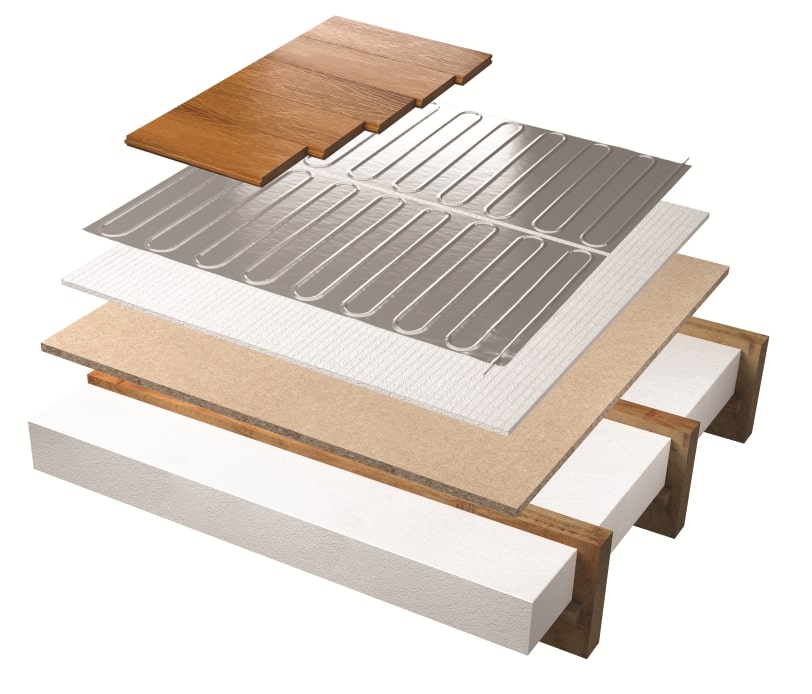Imagine stepping out of bed on a chilly winter morning, only to have your bare feet sink into the warm, comforting embrace of your floor. This dream of a perfectly heated home can be a reality with radiant floor heating, and with the right knowledge, even a wood floor can benefit from its magic. But before you start pulling up your planks, it’s crucial to understand the intricacies of installing radiant heat beneath your cherished wooden surface.

Image: mromavolley.com
While the allure of a toasty floor throughout your home is undeniable, combining wood and radiant heat involves navigating a delicate dance of temperature, moisture, and material compatibility. This in-depth guide will equip you with the knowledge and cautionary tales to determine if radiant heat is the right option for your wood floor, and how to install it correctly if you decide to proceed.
The Allure of Warmth Beneath Your Feet
Radiant heating systems work by circulating warm water or electricity through tubing or wires embedded below the floor surface. This gentle, even heat spreads evenly, creating a comfortable and inviting ambiance without the harshness of traditional forced air systems.
For wood floor enthusiasts, the appeal of radiant heat is undeniable. Not only does it banish those icy winter mornings, but it also eliminates the visual clutter of radiators and vents, promoting a sleek, minimalist aesthetic. With a radiant floor, your home is not only warmer, but also boasts a clean and modern feel.
The Challenges of Wood and Radiant Heat
However, the relationship between wood flooring and radiant heat isn’t always a harmonious one. Wood is a living material, susceptible to moisture fluctuations and temperature changes. The delicate balance must be carefully considered before installing radiant heat beneath your wood floor.
Here are the key challenges you’ll need to address:
1. Moisture Concerns:
-
Expansion and Contraction: Wood naturally expands when it absorbs moisture and contracts when it dries out. The constant temperature variations from radiant heat can worsen these fluctuations, leading to warping, buckling, or even cracking in your flooring.
-
Moisture Barriers: To minimize the risk of moisture damage, a robust moisture barrier is critical when installing radiant heat beneath wood floor. This barrier should be placed between the subfloor and the radiant heat tubing or wires, effectively sealing off any potential moisture intrusion.
2. Temperature Sensitivity:
-
Species Compatibility: Certain wood species are more sensitive to temperature fluctuations than others. Hardwoods like oak and maple, known for their resilience, are typically a good choice for radiant heat installation. Softer wood species, like pine or spruce, are more prone to warping or cracking due to temperature changes.
-
Installation Techniques: The type of installation method can also affect your wood floor’s response to radiant heat. A nailed-down installation, common for traditional wood floors, generally provides more stability and better resistance to heat-related expansion and contraction. Floating floors, which are laid on a layer of underlayment, are generally less compatible with radiant heat due to their greater susceptibility to movement.
Choosing the Right Radiant Heat System
The type of radiant heat system matters a lot when it comes to wood floors. Here’s a breakdown:
1. Hydronic Radiant Floor Heating:
This system involves circulating hot water through tubing embedded within the floor. It’s energy-efficient, offering a gentle and even heat distribution.
- Considerations: A properly designed hydronic system with a carefully regulated temperature control system can be a viable option for wood floors. However, due to the potential for moisture concerns, careful attention needs to be paid to the moisture barrier and the subfloor’s stability.
2. Electric Radiant Floor Heating:
Electric radiant heat relies on wires embedded within the floor that heat up through electrical resistance. This system is adaptable, requiring less installation complexity than hydronic systems.
- Considerations: While electric radiant heat is generally considered less prone to moisture issues, it’s still important to use a high-quality moisture barrier. Additionally, be aware that high temperatures from electric radiant heat can negatively affect certain wood species, so selecting the right type of wood and proper installation are paramount.

Image: www.warmup.com
Expert Advice for Radiant Heat and Wood Floors
Whether you’re embarking on a new home build or considering retrofitting your existing space, consult with experienced professionals in the fields of flooring and radiant heating. They can provide valuable insights on choosing the right materials, ensuring proper installation, and adjusting the system to address the specific needs of your wood floor.
-
Seek Experienced Flooring Professionals: Partner with a flooring installer specializing in radiant heating and wood floor installations. Their expertise is invaluable in selecting the optimal wood species, ensuring proper installation techniques, and addressing potential risks.
-
Consult Radiant Heat Specialists: Consult with a radiant heat specialist to determine the best system type for your needs. They can help you design a system that meets your specific requirements and minimizes risk to your wood flooring.
-
Don’t Forget the Moisture Barrier: Emphasize the importance of a high-quality moisture barrier with your installer. This crucial step prevents moisture from reaching the wood floor, protecting it from damage and ensuring the longevity of your radiant heating system.
Can You Put Radiant Heat Under A Wood Floor
Living with Warmth and Comfort
Radiant heating, when strategically implemented, can transform your home into an oasis of warmth and comfort. By carefully considering the challenges and following expert guidance, you can enjoy the luxurious feel of radiant heat beneath your wood floor without compromising the integrity of your flooring.
Don’t hesitate to gather information from reputable sources, seek the advice of professionals, and embrace the power of knowledge to guide you towards the perfect radiant heat solution for your wood floor. And when that chilly winter morning arrives, the gentle warmth beneath your feet will be a testament to your wise choice and careful planning.






